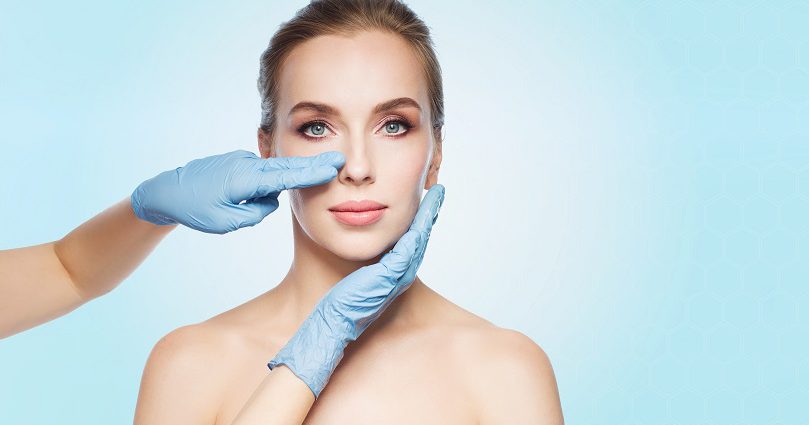Revision (Secondary) Rhinoplasty: Are You a Candidate?

Reviewed by Mark B. Constantian, MD, FACS
Is your nose still too big for your liking? Has your new nose thrown your face out of balance? Did your ethnic rhinoplasty go too far — or not far enough? Or maybe you just want to refine the tip of your nose or are having some breathing problems since your primary nose job.
If any of these scenarios sound familiar, you may be a candidate for revision rhinoplasty. You are not alone. While statistics vary, approximately 15 percent of primary nose jobs require revisions for one reason or another.
For the overwhelming majority of people, the second surgery has to do with a specific cosmetic issue such as a twisted tip or a functional issue like difficulty breathing. The problems may not be the fault of the original surgeon. Not every aspect of healing is under the surgeon’s control, and some anatomical variations can pose particular surgical problems.
Revision Rhinoplasty Considerations
Opting for revision rhinoplasty is not a decision that should be entered into lightly. The revision procedure can be much more complicated than the primary rhinoplasty and requires a surgeon with a sophisticated understanding of nasal structure and surgical technique. As such, it can take longer to perform and may cost significantly more.
Some people return to the plastic surgeon who performed their original procedure for a revision. Others seek out a new surgeon who specializes in revision rhinoplasty. This decision depends on the expertise of the surgeon and your rapport with him or her. Do not return to your original surgeon just because it may be less expensive. Make sure that the surgeon you choose understands why the problem occurred and can fix it.
An open and honest discussion with your surgeon about your expectations and goals is one of the most important steps to a successful procedure and rhinoplasty recovery with your secondary procedure. Ideally, you have had this discussion before your first nose job, which would minimize the need for a secondary rhinoplasty, but there are times when revision rhinoplasty is necessary. Should you need to undergo revision rhinoplasty, be sure to clearly explain why you are unhappy with your first nose surgery.
Today, some surgeons use 3-D imaging programs to show you what your new nose may look like on your face. This sort of virtual mockup can help you better manage your expectations. However, not everything that you may desire, or a surgeon may draw, can be achieved. Your prospective surgeon should also show you examples of noses that replicate your problems and goals, and demonstrate that he or she knows how to produce the look that you want.
During your revision rhinoplasty consultation, your plastic surgeon also will examine your skin, cartilage strength and bone structure, as well as assess the amount of cartilage that is available, because grafting is almost always required. Grafts can create a better shape and support the airway — two reasons for secondary rhinoplasty surgery.
Revision Rhinoplasty: Timing Is Everything
Wait at least one year before considering revision rhinoplasty. While some of the nasal swelling goes down almost immediately, it can take a year for all the swelling to subside. Most surgeons believe a minor amount of swelling lasts even longer. It also takes at least a year for scar tissue to soften (more if you have had two or three previous rhinoplasties), and a firm scar can prevent your surgeon from making a adequate correction. The bottom line is that you will have a more realistic picture of what — if anything — is wrong with your new nose after one year, and your surgeon will be more able to fix it. If you go back for a revision rhinoplasty too soon, you can turn a minor problem into a major disaster; so be patient.
Revision Rhinoplasty Procedure
The revision rhinoplasty procedure is different for everyone. Problems can occur in any area of the nose, including the upper third, the middle third, or the nasal tip. Your revision nose surgery should be customized to address your concerns.
Revision rhinoplasty can be performed with local anesthesia and sedation, or general anesthesia. The surgery can take longer to perform than a primary rhinoplasty, sometimes taking up to four hours to complete. By contrast, a primary rhinoplasty takes one to two hours.
During revision nose surgery, the aim is to restore both structure and function. In some cases, a surgeon may try to recreate symmetry by adding back or taking away cartilage. If needed, extra cartilage can be taken from the nasal septum, your ear or one of your ribs. In general, it is easier to fix problems when not enough cartilage was removed during the primary surgery, because your surgeon can go back and take away more cartilage. More often, however, revision rhinoplasty involves adding cartilage to open the airway or to recreate shape and proportion.
The incisions for revision rhinoplasty can be made on the inside of the nose (closed rhinoplasty), or on the underside of the nose between the nostrils (open rhinoplasty).Closed rhinoplasty has the advantages of being less traumatic and invasive to the tissues because the surgeon only uncovers the areas that need correction, whereas the open approach involves a wider dissection and more disconnection and reconnection of supporting structures. The closed approach may be safer if you have scarring from earlier nose surgeries, but some surgeons prefer the open approach for the exposure that it provides, or to better understand and visualize complicated cases.
Don’t choose your surgeon only because he or she performs a particular technique: find someone who explains the procedure well, makes sense, and whom you trust is looking out for you.
Each revision rhinoplasty is unique. There is no one-size-fits-all revision nose surgery.
Revision Rhinoplasty or Injectable Filler?
To fill or not to fill? That is the question when it comes to tweaking some of the irregularities and asymmetries that occur following rhinoplasty. Revision rhinoplasty is a common, albeit complicated procedure. As such, some surgeons may opt to smooth out resulting imperfections with injectables instead of a repeat operation.
But is this safe? Is it effective? In the right hands and on the right nose, the right filler can do wonders.
Injectable fillers may be cheaper and safer alternatives to a secondary nose surgery, but they are not risk-free nor are they a solution for all imperfections, according to an article in the November/December issue of Aesthetic Surgery Journal. Fillers should not be used in place of primary and/or revision nose surgery; however, some fillers may be able to play a role in minor corrections.
As it stands, hyaluronic acid fillers (such as Restylane and Juvederm), calcium hydroxylapatite gel fillers (like Radiesse) and liquid silicone have all been used off-label to treat nasal deformities. Silicone can be deleterious and may increase risk of severe complications such as nodules, cellulitis and ulceration.
In the same way that the injector technique can make a difference in satisfaction when filling facial folds, such prowess also plays a role in tweaking nasal imperfections. For example, these fillers should not be used in the base and tip of the nose, and should be injected at the proper depth to stave off complications, which may include bumps and lumps.
Revision Rhinoplasty Risks
Revision rhinoplasty, like primary rhinoplasty, comes with its share of risks. They include temporary loss of sense of smell, prolonged swelling, bursting of small blood vessels, excessive scarring and even skin loss, anesthesia complications, and further cosmetic or functional issues. Your surgeon should explain all the rhinoplasty risks to you before you have the surgery.
Revision rhinoplasty is a highly specialized procedure. In fact, some consider it to be the most-complicated cosmetic surgery procedure. For this reason, it is important that you select a board-certified plastic surgeon. Plastic surgeons spend three to four years training in general surgery and the surgical specialties, followed by another three years in a plastic surgery residency.
Plastic surgeons should be certified by the American Board of Plastic Surgery. Board certification assures you that your surgeon has had extensive training, passed rigorous examinations, and is up to date on new technology and techniques.
Make sure that revision rhinoplasty comprises a large part of your surgeon’s practice. Ask how many revision rhinoplasty surgeries your surgeon performs on a yearly basis. He or she should perform 20 to 30 revision rhinoplasty procedures each year.
Ask to view rhinoplasty before and after pictures of other people who have had revision surgery.
Revision Rhinoplasty Recovery
Revision rhinoplasty recovery is similar to primary rhinoplasty recovery. Nasal packing will help reduce swelling and bleeding after surgery, but you will be unable to breathe through your nose until the packing is removed. Your surgeon can prescribe painkillers to help relieve any of the pain associated with the surgery. You may feel nauseated after any surgery. If you have had this problem, alert your surgeon and the anesthesiologist so that you can receive anti-nausea drugs in advance.
There may be some bleeding during the first few days. Applying a cold compress to your forehead can help reduce swelling. It is also a good idea to elevate your head for the first week after surgery and to avoid any trauma to the nose area during the first six to eight weeks after surgery. Blowing your nose should be avoided for two to three weeks after any type of rhinoplasty. However, your airway should be clear as soon as the packs are removed, and the need for nose-blowing (common when the airway is obstructed) should diminish significantly after your surgery.
You will likely be asked to return in three to seven days so the stitches and the cast can be removed. Your nose will still be swollen, but after two weeks much of the swelling will have subsided.
Revision Rhinoplasty Cost
Revision rhinoplasty costs more than primary rhinoplasty. If a primary nose job costs $7,500, a revision can cost $10,000 to $15,000. Any part of the fee that is directly related to correcting airway problems may be covered by your health insurance, although you must cover any costs associated with cosmetic changes. If the rhinoplasty cost is prohibitive, ask your surgeon about monthly payments.
About the Reviewer of This Article
A highly-regarded revision rhinoplasty specialist, Mark B. Constantian, MD, FACS, is in private practice in Nashua, New Hampshire, where he has worked and lived for more than 30 years. He is affiliated with St. Joseph Hospital and Southern New Hampshire Medical Center. Dr. Constantian graduated from Columbia College, received his Bachelor of Medical Sciences degree from Dartmouth Medical School in Hanover, New Hampshire, and his Doctor of Medicine degree from the University of Virginia School of Medicine in Charlottesville. He completed his general surgical training at the University of Virginia Hospital and Boston University Medical Center, and his plastic surgery training at the Medical College of Virginia in Richmond. Dr. Constantian is the past president of the New England Society of Plastic and Reconstructive Surgeons, the Northeastern Society of Plastic Surgeons and The Rhinoplasty Society, and is a past member of the Board of Directors of the American Society of Plastic Surgeons. Dr. Constantian has been an associate editor of Plastic and Reconstructive Surgery. His most recent book, Rhinoplasty: Craft and Magic, was published in May, 2009.



